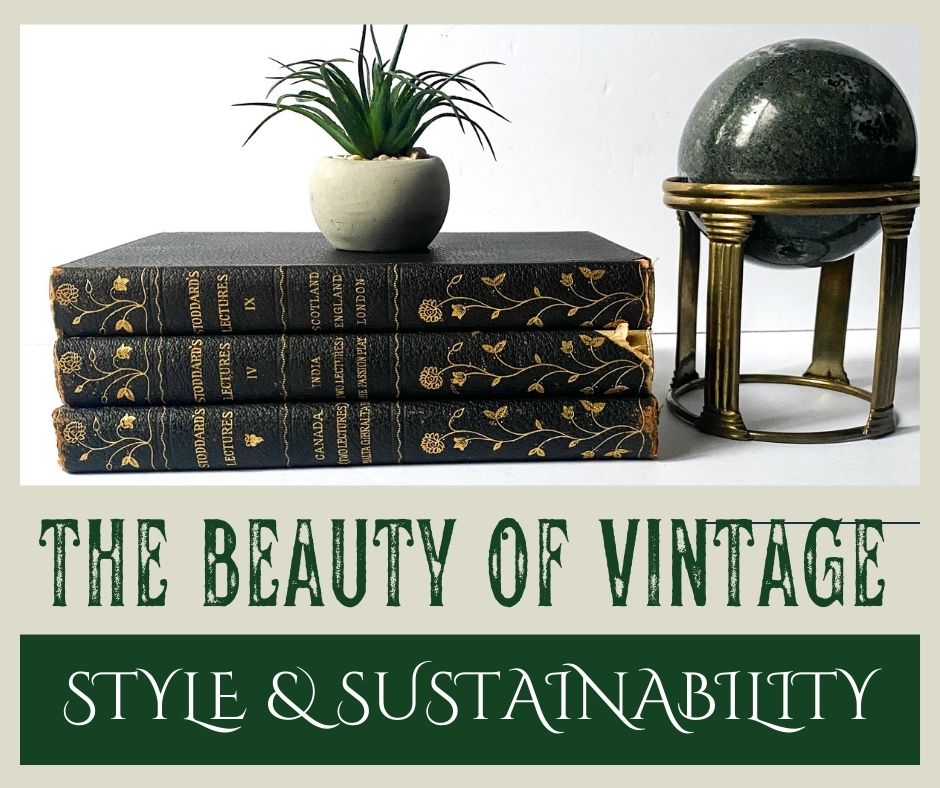
In today's world, where fast fashion and disposable home goods have become the norm, it is more important than ever to consider the impact of our purchasing decisions on the environment. Purchasing vintage home decor instead of new manufactured items is an excellent way to help the Earth. Not only does it reduce waste, but it also helps to preserve the history and craftsmanship of our past. The majority of items here at The Valerie Tyler Collection are 20 or more years old and have stood the test of time, or they are print on demand or small batch artworks that don't strain our resources. They're a more earth friendly alternative to new items that allow us to conserve more.
Want to find out more why choosing vintage over new manufactured goods when you can is so important?
Here are six statistical facts about the reuse of home goods in the United States that illustrate the importance of purchasing vintage:
- According to the Environmental Protection Agency (EPA), in 2018, furniture and furnishings accounted for 9.7 million tons of waste in the United States alone. By choosing to purchase vintage home decor, we can reduce this waste and preserve valuable resources.
- The EPA also reports that the United States generates more than 267.8 million tons of municipal solid waste each year. By purchasing vintage, we can help reduce this waste and limit our impact on the environment.
- According to a study by the online resale platform thredUP, buying secondhand instead of new can reduce a person's carbon footprint by 82%. This reduction comes from the decrease in emissions associated with the production, packaging, and transportation of new items
- The resale market for home goods is growing rapidly, with some reports estimating that it will reach $64 billion by 2024. By purchasing vintage items, we can support this industry and help to reduce waste at the same time.
- Reusing items in the home can also save money. According to the EPA, the average American spends $1,800 per year on furniture and home furnishings. By purchasing vintage, we can save money while also reducing waste and helping the environment.
- Vintage home decor often has a unique charm and character that is difficult to find in new items. By choosing vintage, we can create a truly unique and personalized home that reflects our individual style and personality.
But the benefits of purchasing vintage home decor extend far beyond the borders of the United States. Here are five statistical facts about the reuse of home goods worldwide:
- The United Nations reports that the global population is expected to reach 9.7 billion by 2050. By purchasing vintage home decor, we can help reduce the demand for new manufacturing and limit our impact on the environment.
- The resale market for luxury goods is growing rapidly, with some reports estimating that it will reach $64 billion by 2024. By purchasing vintage luxury home goods, we can support this industry and help to reduce waste at the same time.
- Vintage home decor often has a cultural significance that is difficult to find in new items. By choosing vintage, we can preserve these cultural artifacts and celebrate the history and craftsmanship of our ancestors.
When making purchases for your home, choosing vintage first is an excellent way to help the Earth while also creating a unique and personalized abode. By choosing to reuse instead of buying new, we can reduce waste, limit our impact on the environment, and preserve valuable resources for future generations. Let's make a difference and choose vintage!
Article Citations:
- Environmental Protection Agency. (2020). Municipal Solid Waste Generation, Recycling, and Disposal in the United States: Facts and Figures for 2018. https://www.epa.gov/facts-and-figures-about-materials-waste-and-recycling/national-overview-facts-and-figures-materials
- Environmental Protection Agency. (2020). Advancing Sustainable Materials Management: 2018 Fact Sheet. https://www.epa.gov/sites/production/files/2020-05/documents/2018_smm_advncng_smm_fs_508.pdf
- thredUP. (2018). The Fashion Footprint: How our love for clothes is polluting the planet. https://www.thredup.com/bg/p/the-fashion-footprint
- Business Wire. (2019, August 14). Resale Market for Home Goods Estimated to Reach $64 Billion by 2024, According to New Research from Secondhand Retail Platform OfferUp. https://www.businesswire.com/news/home/20190814005275/en/Resale-Market-for-Home-Goods-Estimated-to-Reach-64-Billion-by-2024-According-to-New-Research-from-Secondhand-Retail-Platform-OfferUp
- Environmental Protection Agency. (2020). National Overview: Facts and Figures on Materials, Wastes and Recycling. https://www.epa.gov/facts-and-figures-about-materials-waste-and-recycling/national-overview-facts-and-figures-materials
- Forbes. (2019, April 30). 5 Reasons Why Vintage Furniture Is the Ultimate Green Choice. https://www.forbes.com/sites/amandalauren/2019/04/30/5-reasons-why-vintage-furniture-is-the-ultimate-green-choice/?sh=64145a9b31f1
Five Statistical Facts About the Reuse of Home Goods Worldwide:
- United Nations Environment Programme. (2018). Sustainable Fashion and Textiles: Design Journeys. https://wedocs.unep.org/bitstream/handle/20.500.11822/25496/sustainablefashion_textiles_design_journeys.pdf?sequence=1&isAllowed=y
- United Nations. (2019). World Population Prospects 2019: Highlights. https://population.un.org/wpp/Publications/Files/WPP2019_10KeyFindings.pdf
- Business Wire. (2019, August 14). Resale Market for Home Goods Estimated to Reach $64 Billion by 2024, According to New Research from Secondhand Retail Platform OfferUp. https://www.businesswire.com/news/home/20190814005275/en/Resale-Market-for-Home-Goods-Estimated-to-Reach-64-Billion-by-2024-According-to-New-Research-from-Secondhand-Retail-Platform-OfferUp
- UNESCO. (n.d.). Intangible Cultural Heritage. https://ich.unesco.org/en/intangible-heritage-00972
- Global Citizen. (2019, June 12). Why You Should Buy Second-Hand Clothing, According to a UN Expert. https://www.globalcitizen.org/en/content/un-expert-sustainable-fashion-second-hand-clothing/

